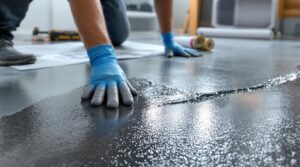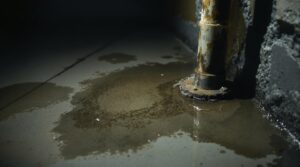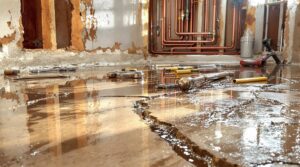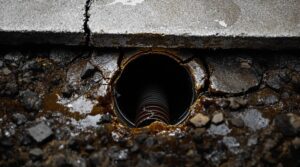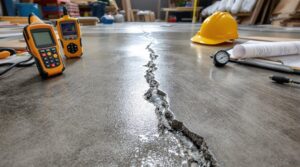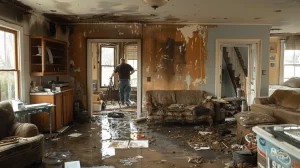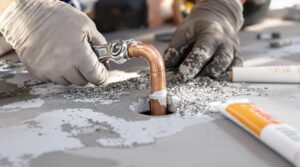Water infiltration through foundation slabs during rainfall occurs primarily through cove joints, foundation cracks, and deteriorated concrete sections. Hydrostatic pressure from saturated soil forces moisture through these vulnerabilities, particularly in areas with high water tables or poor drainage. Common entry points include construction seams, pipe penetrations, and compromised window wells. The severity of seepage correlates directly with rainfall intensity and drainage efficiency. Understanding the specific infiltration mechanisms enables targeted remediation strategies.
Key Takeaways
- Hydrostatic pressure from saturated soil pushes water through cracks and seams where the foundation wall meets the slab.
- Poor drainage around the foundation allows water to accumulate and seep through porous concrete sections.
- Foundation cracks and deteriorated concrete create direct pathways for rainwater to enter through the slab.
- Failed construction joints and pipe penetration points become vulnerable entry areas during heavy rainfall.
- Improperly graded soil directs water toward the foundation instead of away, increasing pressure and seepage potential.
Understanding How Water Enters Foundation Slabs
When water penetrates foundation slabs, it typically follows distinct pathways created by structural vulnerabilities and environmental forces. The primary ingress points include cove joints where the foundation wall meets the slab, existing foundation cracks, and areas of degraded concrete that have become porous over time. These vulnerabilities become particularly problematic during periods of heightened hydrostatic pressure.
Effective water management requires understanding how environmental factors contribute to foundation infiltration. Heavy rainfall and poor yard grading can elevate groundwater levels, while expansive soils and seismic activity may create new entry points through foundation displacement. Ground-level units are especially susceptible to water infiltration due to their proximity to high water tables near lakes and other bodies of water.
Additionally, inadequate moisture control measures, such as improperly maintained gutters or insufficient drainage systems, can result in water accumulation against the foundation. In basement structures, window wells and egress windows present additional vulnerabilities where inadequate sealing or drainage can permit water intrusion, particularly during sustained precipitation events.
Common Signs of Foundation Water Seepage
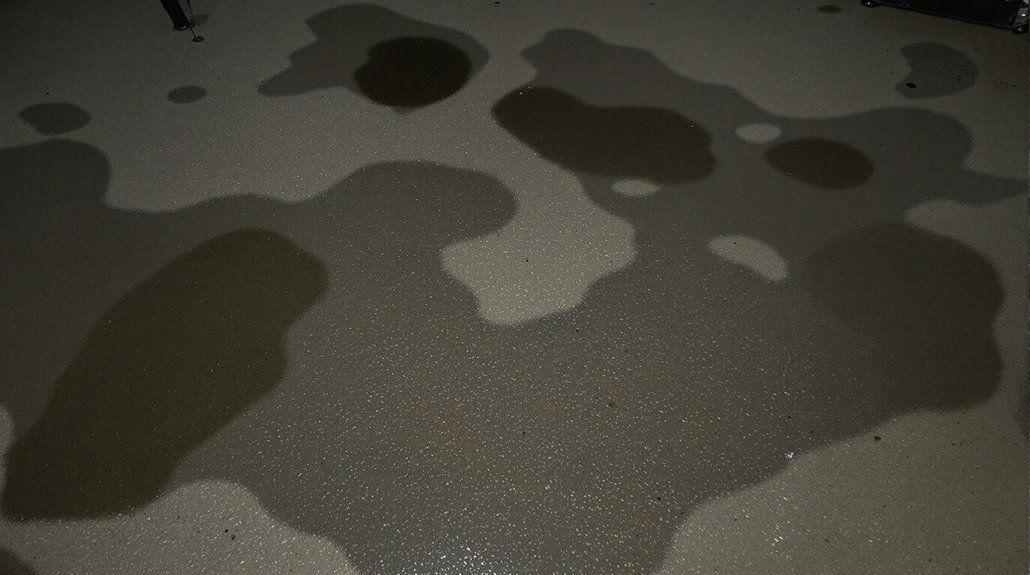
Identifying foundation water seepage requires systematic observation of multiple diagnostic indicators that manifest both externally and internally. During foundation inspections, experts evaluate both structural and moisture control factors to determine the severity of water intrusion. Standing water pooling indicates an immediate need for drainage system assessment and repair.
| Location | Primary Indicators | Secondary Indicators | Assessment Methods |
|---|---|---|---|
| Exterior | Crumbling Concrete | Shifting Soil | Visual Inspection |
| Interior | Efflorescence | Musty Odors | Moisture Testing |
| Structure | Bowing Walls | Foundation Cracks | Load Analysis |
| Slab | Water Seepage | Flooring Damage | Pressure Testing |
Technical analysis reveals that water infiltration typically presents through a progression of symptoms. Initial signs often include efflorescence formation and surface dampness, followed by more severe manifestations such as structural displacement and material deterioration. Advanced indicators may present as hydrostatic pressure-induced wall deformation or compromised floor integrity. These symptoms frequently intensify during precipitation events, particularly in areas with inadequate drainage systems or compromised waterproofing measures.
The Role of Hydrostatic Pressure in Water Infiltration
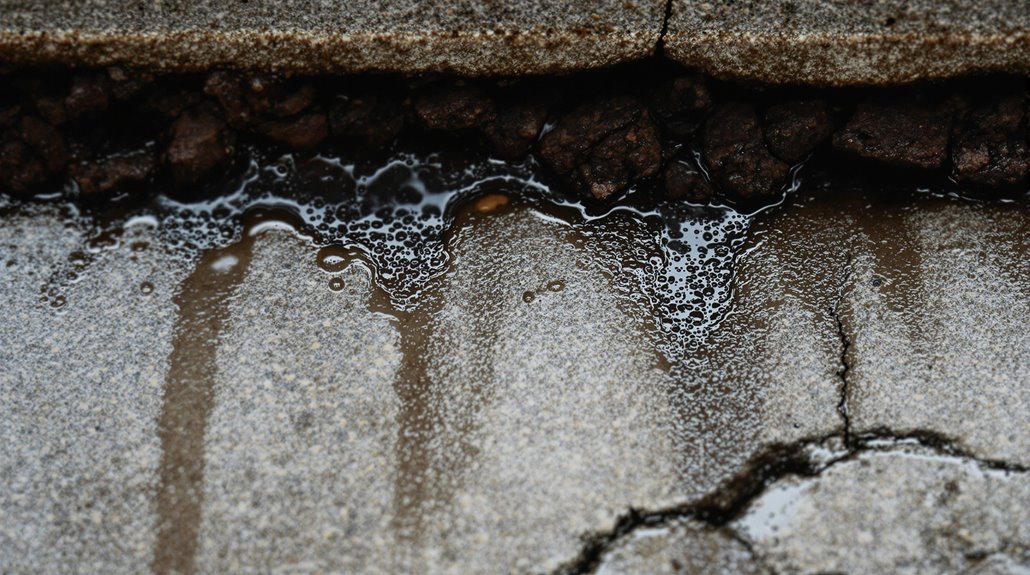
Hydrostatic pressure accumulates when rainwater saturates the soil surrounding a foundation slab, creating significant lateral forces against the concrete structure.
As the water table rises during precipitation events, the pressure differential between the exterior and interior of the foundation increases exponentially with depth, following Pascal's principle.
This heightened pressure gradient forces water molecules through microscopic pathways in the concrete matrix, including pores, cracks, and construction joints, leading to basement water infiltration. Since concrete foundations are engineered primarily for vertical load bearing, the lateral pressure from hydrostatic forces can compromise structural integrity.
Understanding Pressure Build-Up
As groundwater accumulates in the soil surrounding a foundation slab, it exerts an increasing hydrostatic pressure against the concrete structure. This pressure intensifies when soil composition exhibits high water retention characteristics, particularly during periods of heavy rainfall or elevated water table conditions. Poor drainage systems can significantly worsen the pressure buildup against foundation walls.
The progressive build-up of hydrostatic pressure can lead to critical structural vulnerabilities:
- Water molecules infiltrate microscopic concrete pores under increasing pressure.
- Concentrated pressure points develop along foundation weak spots.
- Subsoil stability deteriorates as water saturation increases.
- Structural integrity becomes compromised due to differential pressure distribution.
The severity of pressure accumulation depends on multiple environmental factors, including soil composition, drainage efficiency, and groundwater levels.
When these forces exceed the foundation's designed resistance threshold, water infiltration becomes inevitable, necessitating immediate intervention through proper drainage solutions and waterproofing measures.
Pressure Forces Water Through
The formidable force of hydrostatic pressure drives water molecules through even microscopic pathways in concrete foundation slabs. As groundwater accumulates around the foundation perimeter, the pressure intensifies proportionally with depth, exerting substantial force against the structural elements.
This mechanical process facilitates water intrusion through existing fissures, joints, and porous sections of the concrete matrix. Concrete's inherent non-waterproof nature allows moisture penetration even without visible cracks.
The phenomenon becomes particularly acute during periods of heavy rainfall when saturated soil conditions amplify the hydrostatic pressure against foundation walls and floor slabs.
The pressure differential between the exterior and interior of the foundation creates a gradient that propels moisture through the concrete substrate.
This process can compromise structural integrity through continuous exposure, leading to progressive deterioration of reinforcement materials and concrete composition.
Key Entry Points During Heavy Rainfall
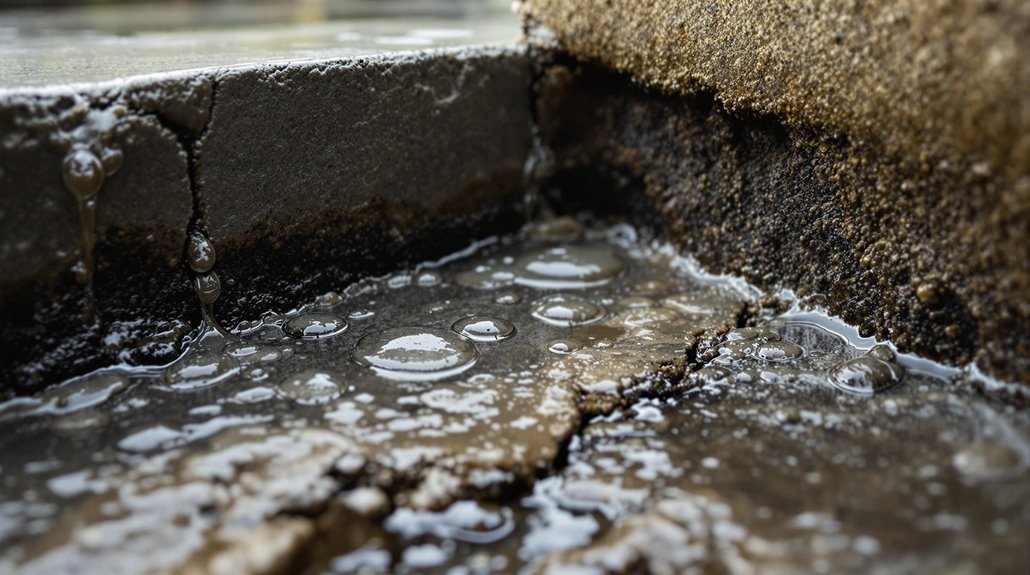
During periods of heavy rainfall, water can infiltrate foundation slabs through multiple essential entry points, creating potential structural vulnerabilities. The primary pathways include foundation cracks, deteriorated concrete sections exhibiting honeycombing, and compromised cove joints where water barriers may have failed. These vulnerabilities often require strategic foundation repairs to maintain structural integrity.
Water infiltration severity typically intensifies through these essential pathways:
- Hydrostatic pressure forces moisture through microscopic concrete pores and structural gaps.
- Window well deterioration enables direct water penetration into subgrade spaces.
- Pipe penetration points develop expanding breach zones during soil saturation.
- Construction seam failures create linear water migration channels.
The combination of expansive soils and inadequate drainage compounds these issues, particularly when groundwater tables rise.
Poor grading and compromised French drain systems further exacerbate water accumulation, leading to increased hydrostatic pressure against the foundation structure.
Understanding these entry points is essential for implementing effective preventive measures.
Immediate Solutions for Water Seepage Problems

When water infiltration occurs through foundation slabs, implementing rapid remediation measures can prevent extensive structural damage and interior water accumulation. A multi-faceted approach combining waterproofing materials and drainage solutions offers ideal protection against water seepage.
Primary interventions include installing drain tile systems with sump pumps to manage hydrostatic pressure and extending downspouts at least 20 feet from the foundation. For compromised structural integrity, applying 2-part epoxy or silicone sealants to cracks, following proper surface preparation protocols, establishes effective barriers against moisture penetration.
Installation of French drains and perforated drainage pipes around the foundation perimeter facilitates water diversion.
Additional waterproofing measures incorporate vapor barriers utilizing 10-20 mil polyethylene sheets, polymer-based liquid membrane coatings, and exterior insulated finish systems.
For superior moisture control, granulated polystyrene foam placement near foundation walls, combined with strategic yard grading adjustments, minimizes water accumulation potential.
Long-Term Prevention Strategies and Waterproofing Methods
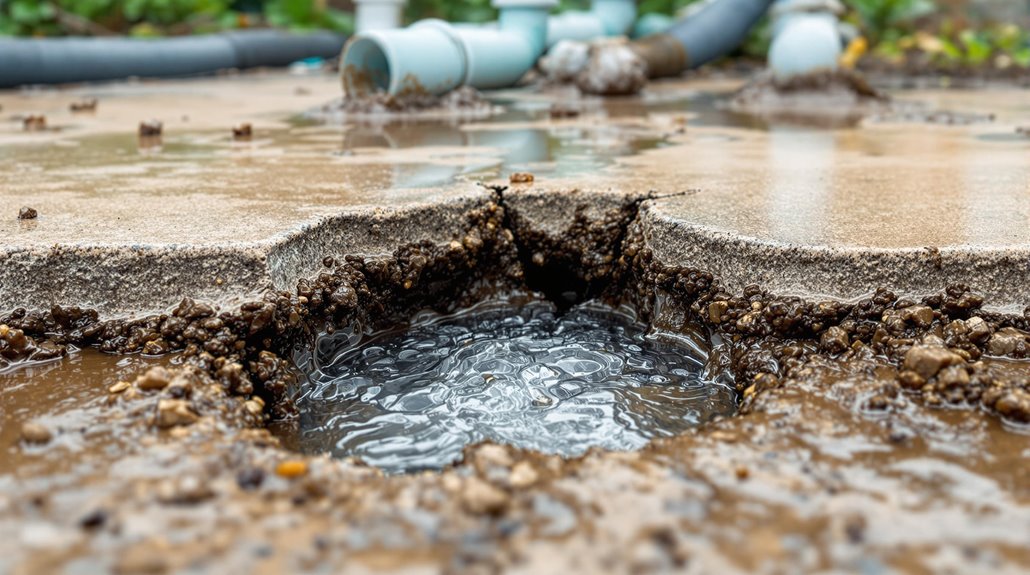
Professional waterproofing solutions necessitate a systematic approach incorporating both exterior and interior methodologies to establish thorough moisture protection for foundation slabs.
The implementation of properly engineered drainage systems, including French drains and interior drainage channels, creates an effective water management infrastructure that diverts groundwater and precipitation away from the foundation.
The integration of multiple waterproofing layers, combined with strategic drainage placement, establishes a robust defense against water infiltration through the foundation slab during periods of heavy rainfall.
Professional Waterproofing Solutions
Modern foundation waterproofing encompasses several extensive solutions designed to prevent water infiltration through concrete slabs and foundation walls.
Professional contractors utilize advanced waterproofing materials and installation techniques, including fully bonded sheet membranes and liquid-applied systems that create impermeable barriers against moisture intrusion.
Key professional solutions that demonstrate proven effectiveness include:
- Pre-applied TPO membranes that prevent lateral water migration
- Wet-bonded HDPE systems with modified bitumen adhesives
- Cold-applied, solvent-free waterproofing compounds for below-grade applications
- Hot-applied rubberized asphalt membranes for enhanced flexibility
These engineered solutions address hydrostatic pressure concerns through systematic application methods that conform to International Building Code requirements.
The integration of vapor barriers with waterproofing systems guarantees thorough protection against both liquid water and water vapor transmission through concrete structures.
Drainage System Installation Tips
Implementing an effective drainage system requires careful attention to multiple critical design elements, including proper trench dimensions, strategic pipe placement, and ideal grading configurations.
The installation process demands a minimum trench depth of 16 inches with equivalent width to accommodate standard drainage materials and protective covering. Critical components include filter fabric installation surrounding the drainage tile and gravel bed to prevent silt infiltration.
The system's efficacy relies on precise slope calculations ensuring water flow toward discharge points, whether daylight emission or sump pit connection.
Proper selection of drainage materials, particularly clean gravel free of fines, prevents system clogging. The installation must incorporate perforated pipe positioning below concrete slabs and outside footings, with thorough waterproofing measures including exterior membranes and vapor barriers to establish a complete moisture management solution.
The Benefits Of Consulting A Public Adjuster

When foundation water damage occurs, consulting a public adjuster provides strategic advantages in managing complex insurance claims processes.
Public adjusters conduct thorough structural assessments using engineering protocols while documenting all visible and latent damage manifestations to establish detailed claim documentation.
Their expertise in policy interpretation and negotiation typically results in more favorable settlement outcomes, with studies indicating considerably higher claim values compared to self-filed claims.
Expertise In Insurance Claims
Most homeowners facing water damage through foundation slabs can benefit greatly from the specialized expertise of public adjusters in insurance claims processing. Their thorough understanding of insurance policy interpretation and claims negotiation strategies guarantees ideal outcomes for policyholders dealing with foundation water damage claims.
Licensed public adjusters provide critical advantages:
- Execute detailed policy analysis to identify all applicable coverage elements
- Document structural damage using forensic assessment methodologies
- Calculate precise damage valuations using industry-standard metrics
- Implement strategic negotiation protocols with insurance carriers
These professionals maintain regulatory compliance while leveraging their technical expertise to maximize claim settlements.
Their systematic approach to claims documentation, combined with their understanding of insurance company procedures, considerably enhances the probability of securing appropriate compensation for foundation water damage repairs.
Objective Damage Assessment
Professional damage assessment conducted by public adjusters provides a systematic and technologically advanced approach to evaluating foundation water damage.
Through the deployment of sophisticated diagnostic tools, including moisture meters, thermal imaging cameras, and aerial drone surveillance, adjusters conduct thorough insurance evaluations that reveal both visible and concealed structural compromises.
These objective assessments utilize infrared technology to detect subsurface water infiltration patterns and identify potential areas of structural deterioration.
The documentation process integrates detailed photographic evidence, moisture level readings, and thermal imaging data to create precise damage assessment reports.
This methodological approach guarantees the identification of secondary damage manifestations, such as mold proliferation or compromised structural integrity, which might otherwise remain undetected during standard visual inspections.
Streamlined Claim Process
Engaging a public adjuster greatly optimizes the insurance claim process through integrated digital workflows and systematic documentation protocols. Their implementation of automated validation systems and eClaim technologies guarantees efficient processing while minimizing documentation errors and administrative delays.
Key advantages of professional claim management include:
- Expedited claim documentation through digital filing systems and real-time tracking mechanisms
- Strategic policy negotiation leveraging industry expertise and thorough damage analysis
- Streamlined communication protocols between stakeholders utilizing automated validation systems
- Enhanced compliance management guaranteeing adherence to policy requirements and deadlines
This systematic approach markedly reduces processing time while maximizing settlement outcomes.
Public adjusters' utilization of optimized workflows and automated systems transforms complex claim procedures into structured, efficient processes that protect policyholder interests while maintaining technical accuracy throughout the settlement phase.
Higher Claim Payouts & Settlements
Statistical analyses demonstrate that public adjusters consistently secure higher claim settlements through their systematic approach to damage assessment and policy optimization.
Their expertise in foundation damage evaluation enables thorough identification of both visible and latent water-related structural issues, leading to more accurate claim valuations.
Public adjusters employ sophisticated insurance claim strategies, utilizing their in-depth knowledge of policy provisions and industry regulations to maximize coverage benefits.
Their proficiency in settlement negotiation tactics counteracts standard insurance company methodologies designed to minimize payouts.
Through meticulous documentation and expert presentation of evidence, they effectively demonstrate the full scope of foundation water damage, resulting in settlements that more accurately reflect repair costs.
This specialized advocacy typically yields considerably higher compensation compared to policyholder-managed claims.
About The Public Claims Adjusters Network (PCAN)
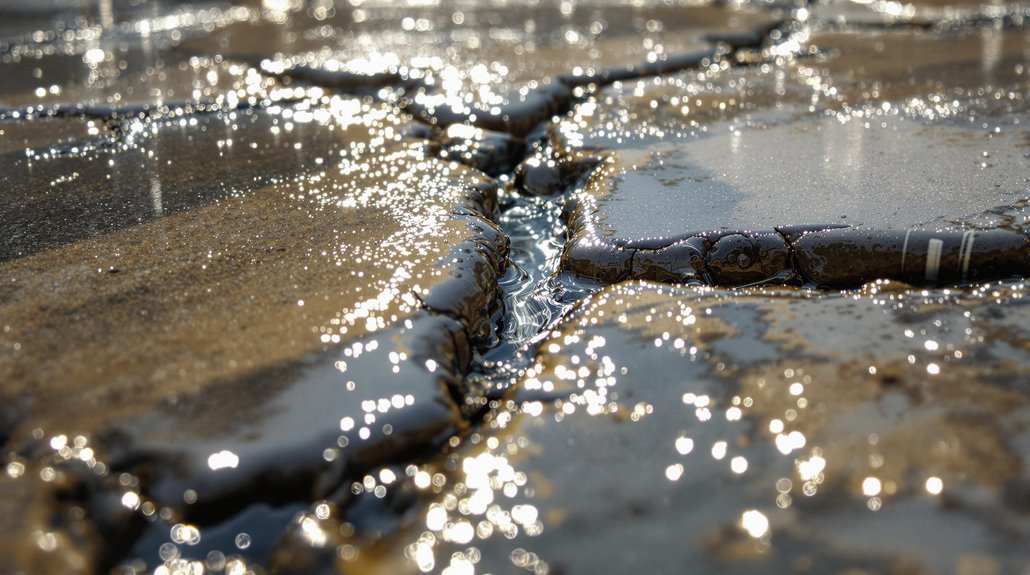
The Public Claims Adjusters Network (PCAN) represents a consortium of licensed insurance claim specialists who operate under standardized protocols to maximize policyholder recovery outcomes. This network of claims assistance professionals leverages collective expertise to navigate complex insurance processes, achieving documented settlement increases of up to 747 percent compared to non-represented claims.
Public Adjusters within PCAN implement systematic methodologies for claim assessment and negotiation, utilizing industry-standard documentation procedures and advanced damage evaluation techniques. Their thorough approach encompasses:
- Forensic analysis of structural water infiltration patterns
- Detailed documentation of foundation slab degradation metrics
- Systematic evaluation of subsurface hydrostatic pressure indicators
- Quantitative assessment of water-induced foundation displacement
PCAN members operate under a contingency-based compensation model, eliminating upfront costs while maintaining alignment with policyholder interests.
Their specialized knowledge of insurance policy interpretation and claims procedures guarantees peak settlement outcomes through evidence-based negotiation strategies and detailed documentation protocols.
Frequently Asked Questions
How Much Does Professional Foundation Waterproofing Typically Cost?
Professional foundation waterproofing costs average $5,213, ranging from $2,459 to $8,181, depending on waterproofing methods selected, square footage, and whether interior or exterior foundation repair techniques are implemented.
Can Foundation Water Damage Affect My Home's Resale Value?
Foundation water damage critically impacts resale implications through compromised structural integrity. Market perception deteriorates considerably, with potential devaluation ranging from 10-30% depending on severity and remediation status.
Is Foundation Water Seepage Covered by Standard Homeowner's Insurance?
Standard homeowner's insurance policies typically exclude foundation coverage for seepage, except when caused by sudden, accidental events. Specialized endorsements or additional policies may be required for thorough foundation protection.
How Long Does a Properly Waterproofed Foundation Typically Last?
Professional foundation waterproofing materials typically maintain effectiveness for 5-10 years, though premium systems can extend lifespan expectations to 30+ years when properly installed and maintained under ideal conditions.
What Signs Indicate My Foundation Problems Require Immediate Professional Attention?
Like fault lines in bedrock, structural integrity warnings manifest through cracked walls exceeding 1/4 inch, diagonal fractures, moisture buildup, uneven floor displacement, and door/window misalignment requiring immediate engineering assessment.
References
- https://www.therealsealllc.com/blog/water-seeping-through-foundation-slab-hydrostatic-pressure-and-mor/
- https://drycretewp.com/a-comprehensive-guide-to-basement-concrete-slab-waterproofing/
- https://dalinghausconstruction.com/blog/water-coming-up-from-the-floor-slab/
- https://hacklerplumbingmckinney.com/why-water-coming-up-through-slab-after-rain/
- https://foundationrepairs.com/foundation-maintenance/concrete-foundation-waterproofing-stop-source/
- https://www.allstarplumbingservice.com/blog/water-seeping-through-foundation-slab/
- https://www.dalinghausconstruction.com/blog/water-coming-up-from-the-floor-slab/
- https://www.olshanfoundation.com/foundation-repair/foundation-problems-causes/water-leak-under-slab/
- https://www.afsrepair.com/resources/basement-waterproofing/water-seepage/
- https://www.budgetbasement.com/how-to-spot-a-foundation-leak/
